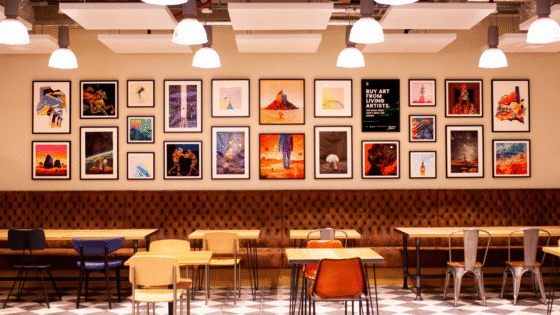As the industry prepares to makes its grand return, there’s a debate forming around art’s vital role in meaningful interior design in hospitality. Hotel Designs asks the consultants at Portobello Art to investigate…
Art has always been present in hotels, but the role of art has evolved hugely over the last 20 years, possibly more so than any other element of hotel design.

In the 1990s and early 2000s hotel guests would see the same uninspired art of flower paintings and landscapes again and again in hotels all over the country. But the main reason for this wasn’t just the brands – it was also the technology.
It was poster artwork, where everything was on paper and what you saw is exactly what you got. The sole technology available 20 years ago was to buy cheap, mass-produced art from poster catalogues which were printed using offset lithography. Designers, chains and franchises would literally have to choose their images from the dozens of catalogues that were available to everybody, then hang them in nondescript frames.
But now, thanks to the digital revolution, printing pictures and customising them, is now so much more accessible. You can create any image in any colour, any size and you can print them on to a wide variety of materials. This has given hoteliers far more options for choosing artwork and tailoring it to fit their brand and location.
Art is no longer used as an accessory, nor as a way of following protocol for typical hotel design, but as a way of evoking emotion, playing a significant role in promoting the unique identity of a hotel and is recognised as being a key component of creating the feel and atmosphere and bringing colour, vitality and inspiration to all environments.
Something Angela Rawson, Director of AJ&Co Interior Design, with whom we’ve worked on several projects, wholeheartedly agrees. “The trend for personalisation, authenticity and a unique experience within hotel interior design is here to stay,” she says. “Hotels strive to create a sense of place for their guests to immerse themselves in local history, culture, and heritage. Visual art and curated pieces not only play a huge part in conveying this personalisation through the interior design but can add statement and talking point – whether it is literal or abstracted interpretation.
“Considered artwork enriches the personality and ambiance of a space and ties together the design narrative and interior design.”
So what kind of artwork can we expect to see?
Framed Prints are still very popular but with the help of digital enhancement even a group of framed images can mean so much more than a couple of pictures hanging on a wall as they used to be years ago. The framed images above were all created from different sized local images (of Edinburgh), enlarged, then close up details were cropped out, all resized to the same size and framed in the same simple style to create an interesting but uniform collection of prints.
At Portobello, almost every hotel project is for bespoke products and the style is different every time. Usually hoteliers or hotel designers will have a concept in mind with a particular theme, but it varies greatly depending on the hotel size, style and location. Generally we will advise on what sort of artwork would work best to create the right look and ambience in that particular hotel, whether it be for framed or canvas prints, mirrors, digital wallpaper or bric-a-brac.
There will usually be either a theme or colour scheme that would need to be adhered to and as art consultants, Portobello have access to literally millions of images from online image banks and we are happy to source these for you and with our technical expertise and in-house design capabilities we can then adapt any image to fit your individual requirements.
A prime example of this was a project for the Cigar room at 10 Manchester Street, London, where the designer wanted a gallery wall of cigar smoking celebrities which we suggested should be oil paintings rather than framed prints. So we asked our in-house artists for their own interpretation and were delighted with the overall effect.
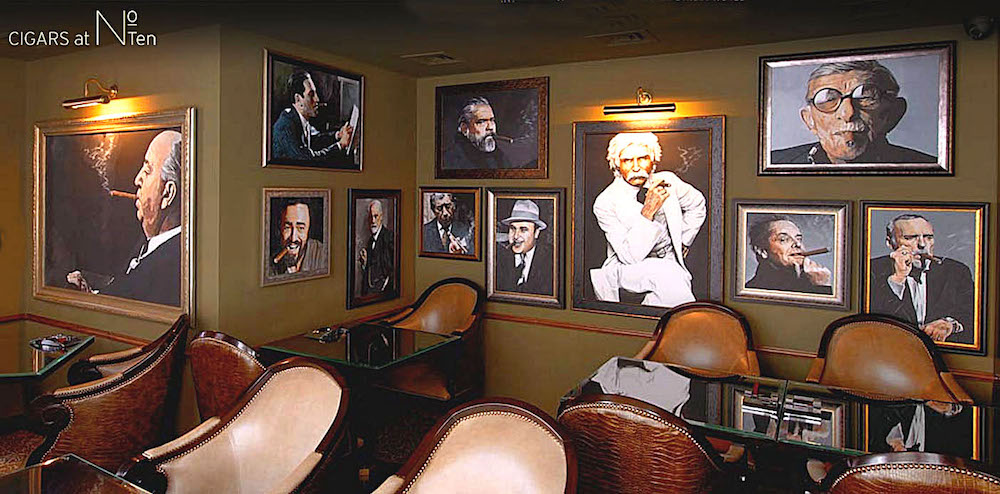
Image credit: Bespoke Hotels – No. Ten Manchester Street/Portobello Art
Artwork must not only have relevance to the hotel’s design and location but must also be fun and memorable, tell a story and therefore make their hotel stand out from the crowd.
Digitally printed wallpaper has been popular for years for feature walls in open spaces, but one-piece wallpaper has gone a step further. This eradicates any previous issues, such as joining intrinsic designs seamlessly, as the ‘One Piece’ covers expansive areas eliminating the need for seams. There have always been some limitations with certain designs and images (like maps and faces) where the joins are notoriously difficult to match up but with one piece wallpaper the image is printed seamlessly up to five metres high and almost any width imaginable! This has now given us the ability to create enormous collages made up of numerous individual images which was not previously possible with normal digitally printed wallpaper.
One example which illustrates this is the Holiday Inn in Liverpool where they wanted to add some interest to a huge blank wall in the restaurant. This was great fun to create, first sourcing all the separate images, in a Liverpudlian theme of course, and then merging them all together to create a dramatic collage.
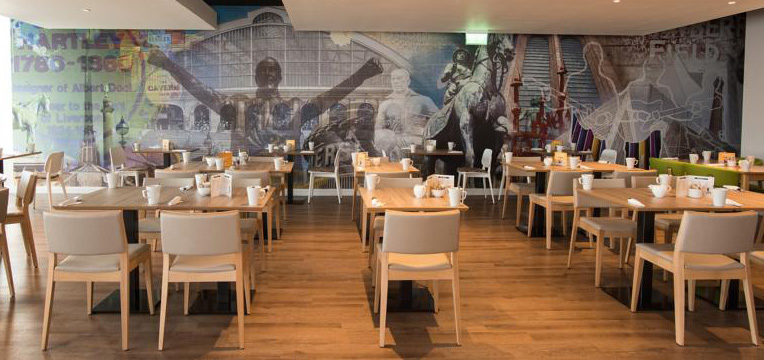
Image credit: Holiday Inn/Portobello Art
Visual art in hotels and their public spaces influences a visitor’s first impressions, and sets the tone for the rest of the hotel. Artwork isn’t just what hangs on the walls but also the Bric-a-brac (decorative accessories) displayed around the open spaces. One of the biggest trends over the last few years has been in hotel lobbies where it is no longer just a place for arrivals and departures. IHG’s introduction in 2013 of the Open Lobby Concept has created a flexible environment were guests can eat, drink, work, meet, relax, socialise and have fun in one integrated space.
Portobello is delighted to have been involved in IHG’s concept from the beginning and have provided artwork and bric-a-brac for many Holiday Inns over the last few years and indeed, as this trend has taken hold, to other hotel chains who are also embracing the concept as well.

Image credit: Holiday Inn/Portobello Art
Can a hotel be updated / refurbished by changing the artwork alone?
As a hotel owner or manager, you might dread the idea of going through a renovation. After all, it’s a huge expense — one that often requires you to scale back operations for a period of time and all of the work can be an inconvenience to your guests, which in turn can have an impact on future business.
However, simply avoiding renovations isn’t a wise choice, since it can diminish the attraction and value of your property.
So updating the artwork every 2 or 3 years, with a new coat of paint on the walls, could definitely give a refreshing lift to a hotel without going through the upheaval of a full renovation and replacing all the furniture, carpets and wallcoverings etc.
Certainly for bedrooms or corridors this is entirely possible. Normally the standard bedroom artwork will be fairly understated so designers often have one large piece of artwork above the bed, and these could easily be changed every few years.
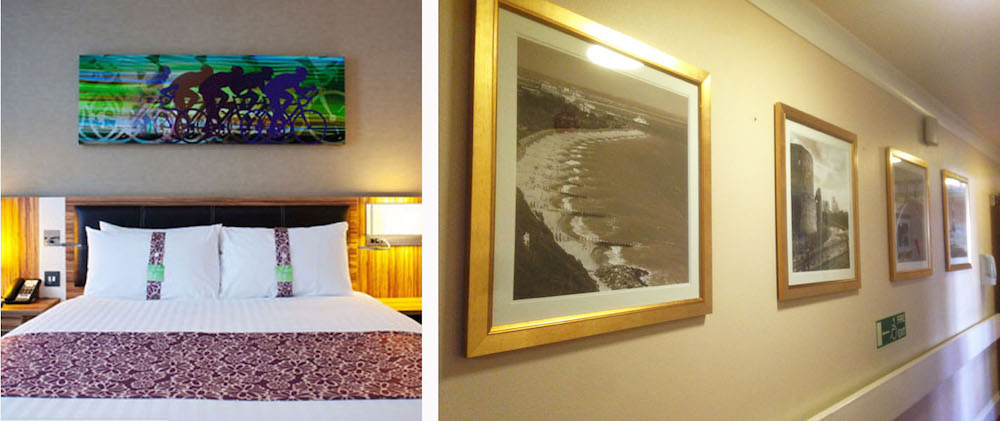
Image credit: Holiday Inn/Portobello Art
It would be a bit more challenging in the lobby and reception areas where something more dramatic and memorable is needed to create that real WOW factor but as long as existing artwork can be replaced with a new image that compliments the existing décor.
This can be seen in the images below where we provided artwork for two very different hotels. The ultra-modern Holiday Inn in the centre of Bristol wanted a local image so we suggested having a black and white image of Brunel’s S.S. Great Britain, and created it as a huge picture on multiple tiled canvas prints. It certainly brought some drama to the contemporary reception area. And for The Langley, a luxurious 18th century manor house in Buckinghamshire, it had to be original paintings showing the opulence and timeless luxury of elegant country living.
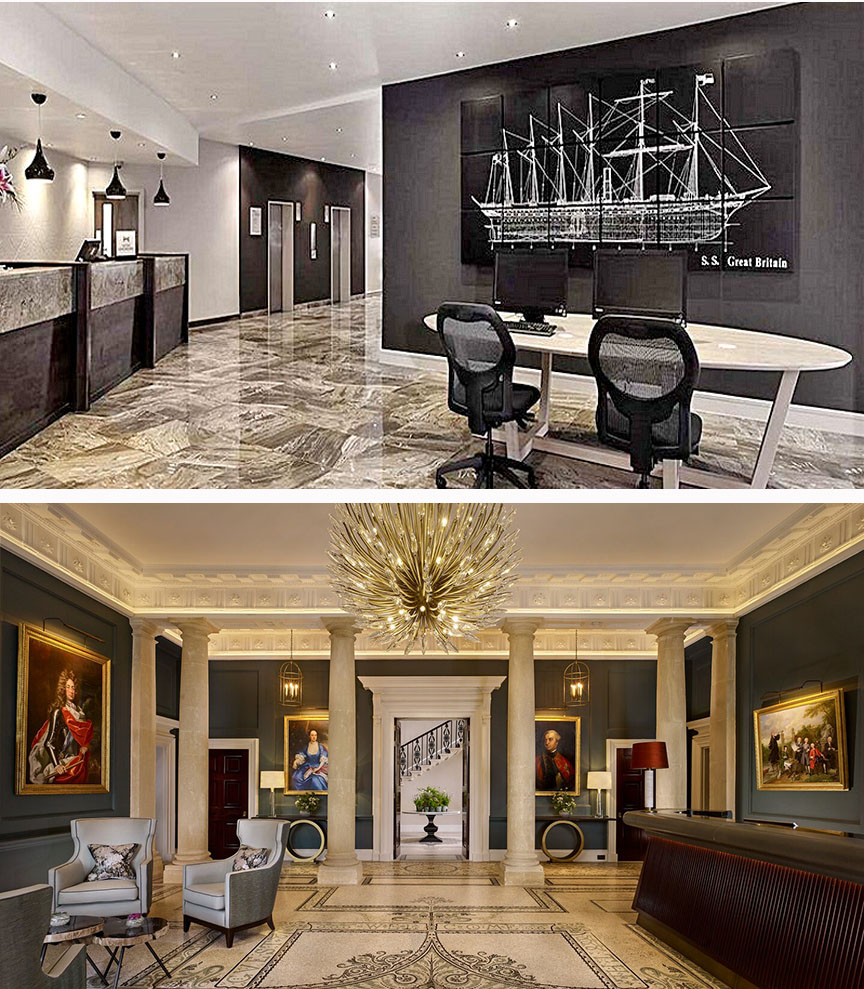
Image credit: Holiday Inn/Portobello Art and The Langley, Marriott/Portobello Art
There has always been artwork on display in hotels but in the last 10 years art has become very on trend and in some cases is almost used as therapy; it can help inspire, console, comfort and reawaken us, and is necessary to create these emotions and lure the guest into the whole experience. Various scientific studies show that when looking at a beautiful art piece, you feel better, so it helps in uplifting the mood of the guests and making them feel at ease in that perfectly designed space.
Another designer we’ve done work for, Joanna Knight of J K Interiors, reinforces this. “The use of artwork in hospitality interiors is absolutely integral to the interior scheme,” she explains. “It can pull a whole scheme together, convey a deeper meaning to the guest, and invoke an emotional response that comforts, excites or stirs the inquisitive mind.
“Whatever feeling the designer is trying to elicit, can be reinforced or enhanced by the use of appropriate artwork. Conversely, poorly thought through and executed artwork can leave the guest feeling ‘flat’ and underwhelmed – which in turn can colour their judgement of the hospitality space and the time they want to spend in it.”
From boutique hotels to international chains all hotels will usually remain faithful to their brand image, simply because brand matters more than anything else in the hospitality industry. Guests will often choose the same hotel chain because they like the “feel” of it. Every aspect of the decor, including the art, needs to provide that comforting familiarity.
While artwork may not always be the first thing guests notice when they walk into a hotel, it can certainly make a big impact on the overall design and feel. When done right, artwork can be the focal point of any hotel lobby or guestroom, and should be considered as important as any other major design element.
Portobello Art is one of the brands that has taken advantage of our Industry Support Package. To keep up to date with supplier news, click here. And, if you are interested in also benefitting from this three-month editorial package, please email Katy Phillips by clicking here.
Main image credit: Marriott Courtyard/Portobello Art

